Open Graphics Library (OpenGL) is a cross-language, cross-platform application programming interface (API) for rendering 2D and 3D vector graphics. The API is typically used to interact with a graphics processing unit (GPU), to achieve hardware-accelerated rendering.
Silicon Graphics Inc., (SGI) began developing OpenGL in 1991 and released it on June 30, 1992; applications use it extensively in the fields of computer-aided design (CAD), virtual reality, scientific visualization, information visualization, flight simulation, and video games. Since 2006, OpenGL has been managed by the non-profit technology consortium Khronos Group.
Design
An illustration of the graphics pipeline process
The OpenGL specification describes an abstract API for drawing 2D and 3D graphics. Although it is possible for the API to be implemented entirely in software, it is designed to be implemented mostly or entirely in hardware.
The API is defined as a set of functions which may be called by the client program, alongside a set of named integer constants (for example, the constant GL_TEXTURE_2D, which corresponds to the decimal number 3553). Although the function definitions are superficially similar to those of the programming language C, they are language-independent. As such, OpenGL has many language bindings, some of the most noteworthy being the JavaScript binding WebGL (API, based on OpenGL ES 2.0, for 3D rendering from within a web browser); the C bindings WGL, GLX and CGL; the C binding provided by iOS; and the Java and C bindings provided by Android.
In addition to being language-independent, OpenGL is also cross-platform. The specification says nothing on the subject of obtaining, and managing an OpenGL context, leaving this as a detail of the underlying windowing system. For the same reason, OpenGL is purely concerned with rendering, providing no APIs related to input, audio, or windowing.
Development
OpenGL is an evolving API. New versions of the OpenGL specifications are regularly released by the Khronos Group, each of which extends the API to support various new features. The details of each version are decided by consensus between the Group’s members, including graphics card manufacturers, operating system designers, and general technology companies such as Mozilla and Google.
In addition to the features required by the core API, graphics processing unit (GPU) vendors may provide additional functionality in the form of extensions. Extensions may introduce new functions and new constants, and may relax or remove restrictions on existing OpenGL functions. Vendors can use extensions to expose custom APIs without needing support from other vendors or the Khronos Group as a whole, which greatly increases the flexibility of OpenGL. All extensions are collected in, and defined by, the OpenGL Registry.
Each extension is associated with a short identifier, based on the name of the company which developed it. For example, Nvidia’s identifier is NV, which is part of the extension name GL_NV_half_float, the constant GL_HALF_FLOAT_NV, and the function glVertex2hNV(). If multiple vendors agree to implement the same functionality using the same API, a shared extension may be released, using the identifier EXT. In such cases, it could also happen that the Khronos Group’s Architecture Review Board gives the extension their explicit approval, in which case the identifier ARB is used.
The features introduced by each new version of OpenGL are typically formed from the combined features of several widely implemented extensions, especially extensions of type ARB or EXT.
OpenGL
Before starting our journey we should first define what OpenGL actually is. OpenGL is mainly considered an API (an Application Programming Interface) that provides us with a large set of functions that we can use to manipulate graphics and images. However, OpenGL by itself is not an API, but merely a specification, developed and maintained by the Khronos Group.
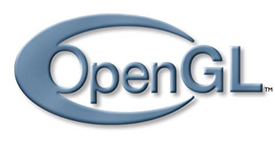
The OpenGL specification specifies exactly what the result/output of each function should be and how it should perform. It is then up to the developers implementing this specification to come up with a solution of how this function should operate. Since the OpenGL specification does not give us implementation details, the actual developed versions of OpenGL are allowed to have different implementations, as long as their results comply with the specification (and are thus the same to the user).
The people developing the actual OpenGL libraries are usually the graphics card manufacturers. Each graphics card that you buy supports specific versions of OpenGL which are the versions of OpenGL developed specifically for that card (series). When using an Apple system the OpenGL library is maintained by Apple themselves and under Linux there exists a combination of graphic suppliers’ versions and hobbyists’ adaptations of these libraries. This also means that whenever OpenGL is showing weird behavior that it shouldn’t, this is most likely the fault of the graphics cards manufacturers (or whoever developed/maintained the library).Since most implementations are built by graphics card manufacturers. Whenever there is a bug in the implementation this is usually solved by updating your video card drivers; those drivers include the newest versions of OpenGL that your card supports. This is one of the reasons why it’s always advised to occasionally update your graphic drivers.
Khronos publicly hosts all specification documents for all the OpenGL versions. The interested reader can find the OpenGL specification of version 3.3 (which is what we’ll be using) here which is a good read if you want to delve into the details of OpenGL (note how they mostly just describe results and not implementations). The specifications also provide a great reference for finding the exact workings of its functions.
Core-profile vs Immediate mode
In the old days, using OpenGL meant developing in immediate mode (often referred to as the fixed function pipeline) which was an easy-to-use method for drawing graphics. Most of the functionality of OpenGL was hidden inside the library and developers did not have much control over how OpenGL does its calculations. Developers eventually got hungry for more flexibility and over time the specifications became more flexible as a result; developers gained more control over their graphics. The immediate mode is really easy to use and understand, but it is also extremely inefficient. For that reason the specification started to deprecate immediate mode functionality from version 3.2 onwards and started motivating developers to develop in OpenGL’s core-profile mode, which is a division of OpenGL’s specification that removed all old deprecated functionality.
When using OpenGL’s core-profile, OpenGL forces us to use modern practices. Whenever we try to use one of OpenGL’s deprecated functions, OpenGL raises an error and stops drawing. The advantage of learning the modern approach is that it is very flexible and efficient. However, it’s also more difficult to learn. The immediate mode abstracted quite a lot from the actual operations OpenGL performed and while it was easy to learn, it was hard to grasp how OpenGL actually operates. The modern approach requires the developer to truly understand OpenGL and graphics programming and while it is a bit difficult, it allows for much more flexibility, more efficiency and most importantly: a much better understanding of graphics programming.
This is also the reason why the tutorials are geared at core-profile OpenGL version 3.3. Although it is more difficult, it is greatly worth the effort.
As of today, higher versions of OpenGL are available to choose from (at the time of writing 4.5) at which you might ask: why do I want to learn OpenGL 3.3 when OpenGL 4.5 is out? The answer to that question is relatively simple. All future versions of OpenGL starting from 3.3 add extra useful features to OpenGL without changing OpenGL’s core mechanics; the newer versions just introduce slightly more efficient or more useful ways to accomplish the same tasks. The result is that all concepts and techniques remain the same over the modern OpenGL versions so it is perfectly valid to learn OpenGL 3.3. Whenever you’re ready and/or more experienced you can easily use specific functionality from more recent OpenGL versions.When using functionality from the most recent version of OpenGL, only the most modern graphics cards will be able to run your application. This is often why most developers generally target lower versions of OpenGL and optionally enable higher version functionality.
In some tutorials you’ll sometimes find more modern features which are noted down as such.
Extensions
A great feature of OpenGL is its support of extensions. Whenever a graphics company comes up with a new technique or a new large optimization for rendering this is often found in an extension implemented in the drivers. If the hardware an application runs on supports such an extension the developer can use the functionality provided by the extension for more advanced or efficient graphics. This way, a graphics developer can still use these new rendering techniques without having to wait for OpenGL to include the functionality in its future versions, simply by checking if the extension is supported by the graphics card. Often, when an extension is popular or very useful it eventually becomes part of future OpenGL versions.
The developer has to query whether any of these extensions are available before using them (or use an OpenGL extension library). This allows the developer to do things better or more efficient, based on whether an extension is available:
if(GL_ARB_extension_name)
{
// Do cool new and modern stuff supported by hardware
}
else
{
// Extension not supported: do it the old way
}
With OpenGL version 3.3 we rarely need an extension for most techniques, but wherever it is necessary proper instructions are provided.
State machine
OpenGL is by itself a large state machine: a collection of variables that define how OpenGL should currently operate. The state of OpenGL is commonly referred to as the OpenGL context. When using OpenGL, we often change its state by setting some options, manipulating some buffers and then render using the current context.
Whenever we tell OpenGL that we now want to draw lines instead of triangles for example, we change the state of OpenGL by changing some context variable that sets how OpenGL should draw. As soon as we change the context by telling OpenGL it should draw lines, the next drawing commands will now draw lines instead of triangles.
When working in OpenGL we will come across several state-changing functions that change the context and several state-using functions that perform some operations based on the current state of OpenGL. As long as you keep in mind that OpenGL is basically one large state machine, most of its functionality will make more sense.
Objects
The OpenGL libraries are written in C and allows for many derivations in other languages, but in its core it remains a C-library. Since many of C’s language-constructs do not translate that well to other higher-level languages, OpenGL was developed with several abstractions in mind. One of those abstractions are objects in OpenGL.
An object in OpenGL is a collection of options that represents a subset of OpenGL’s state. For example, we could have an object that represents the settings of the drawing window; we could then set its size, how many colors it supports and so on. One could visualize an object as a C-like struct:
struct object_name {
float option1;
int option2;
char[] name;
};
Whenever we want to use objects it generally looks something like this (with OpenGL’s context visualized as a large struct):
// The State of OpenGL
struct OpenGL_Context {
...
object_name* object_Window_Target;
...
};
// create object
unsigned int objectId = 0;
glGenObject(1, &objectId);
// bind/assign object to context
glBindObject(GL_WINDOW_TARGET, objectId);
// set options of object currently bound to GL_WINDOW_TARGET
glSetObjectOption(GL_WINDOW_TARGET, GL_OPTION_WINDOW_WIDTH, 800);
glSetObjectOption(GL_WINDOW_TARGET, GL_OPTION_WINDOW_HEIGHT, 600);
// set context target back to default
glBindObject(GL_WINDOW_TARGET, 0);
This little piece of code is a workflow you’ll frequently see when working with OpenGL. We first create an object and store a reference to it as an id (the real object’s data is stored behind the scenes). Then we bind the object (using its id) to the target location of the context (the location of the example window object target is defined as GL_WINDOW_TARGET). Next we set the window options and finally we un-bind the object by setting the current object id of the window target to 0. The options we set are stored in the object referenced by objectId and restored as soon as we bind the object back to GL_WINDOW_TARGET.The code samples provided so far are only approximations of how OpenGL operates; throughout the tutorial you will come across enough actual examples.
The great thing about using these objects is that we can define more than one object in our application, set their options and whenever we start an operation that uses OpenGL’s state, we bind the object with our preferred settings. There are objects for example that act as container objects for 3D model data (a house or a character) and whenever we want to draw one of them, we bind the object containing the model data that we want to draw (we first created and set options for these objects). Having several objects allows us to specify many models and whenever we want to draw a specific model, we simply bind the corresponding object before drawing without setting all their options again.
Let’s get started
You now learned a bit about OpenGL as a specification and a library, how OpenGL approximately operates under the hood and a few custom tricks that OpenGL uses. Don’t worry if you didn’t get all of it; throughout the tutorial we’ll walk through each step and you’ll see enough examples to really get a grasp of OpenGL. If you’re ready for the next step we can start creating an OpenGL context and our first window.
Creating a window
The first thing we need to do before we start creating stunning graphics is to create an OpenGL context and an application window to draw in. However, those operations are specific per operating system and OpenGL purposefully tries to abstract itself from these operations. This means we have to create a window, define a context, and handle user input all by ourselves.
Luckily, there are quite a few libraries out there that provide the functionality we seek, some specifically aimed at OpenGL. Those libraries save us all the operation-system specific work and give us a window and an OpenGL context to render in. Some of the more popular libraries are GLUT, SDL, SFML and GLFW. On LearnOpenGL we will be using GLFW. Feel free to use any of the other libraries, the setup for most is similar to GLFW’s setup.
GLFW
GLFW is a library, written in C, specifically targeted at OpenGL. GLFW gives us the bare necessities required for rendering goodies to the screen. It allows us to create an OpenGL context, define window parameters, and handle user input, which is plenty enough for our purposes.
The focus of this and the next chapter is to get GLFW up and running, making sure it properly creates an OpenGL context and that it displays a simple window for us to mess around in. This chapter takes a step-by-step approach in retrieving, building and linking the GLFW library. We’ll use Microsoft Visual Studio 2019 IDE as of this writing (note that the process is the same on the more recent visual studio versions). If you’re not using Visual Studio (or an older version) don’t worry, the process will be similar on most other IDEs.
Building GLFW
GLFW can be obtained from their webpage’s download page. GLFW already has pre-compiled binaries and header files for Visual Studio 2012 up to 2019, but for completeness’ sake we will compile GLFW ourselves from the source code. This is to give you a feel for the process of compiling open-source libraries yourself as not every library will have pre-compiled binaries available. So let’s download the Source package.We’ll be building all libraries as 64-bit binaries so make sure to get the 64-bit binaries if you’re using their pre-compiled binaries.
Once you’ve downloaded the source package, extract it and open its content. We are only interested in a few items:
- The resulting library from compilation.
- The include folder.
Compiling the library from the source code guarantees that the resulting library is perfectly tailored for your CPU/OS, a luxury pre-compiled binaries don’t always provide (sometimes, pre-compiled binaries are not available for your system). The problem with providing source code to the open world however is that not everyone uses the same IDE or build system for developing their application, which means the project/solution files provided may not be compatible with other people’s setup. So people then have to setup their own project/solution with the given .c/.cpp and .h/.hpp files, which is cumbersome. Exactly for those reasons there is a tool called CMake.
CMake
CMake is a tool that can generate project/solution files of the user’s choice (e.g. Visual Studio, Code::Blocks, Eclipse) from a collection of source code files using pre-defined CMake scripts. This allows us to generate a Visual Studio 2019 project file from GLFW’s source package which we can use to compile the library. First we need to download and install CMake that can be found on their download page.
Once CMake is installed you can choose to run CMake from the command line or through their GUI. Since we’re not trying to overcomplicate things we’re going to use the GUI. CMake requires a source code folder and a destination folder for the binaries. For the source code folder we’re going to choose the root folder of the downloaded GLFW source package and for the build folder we’re creating a new directory build and then select that directory.
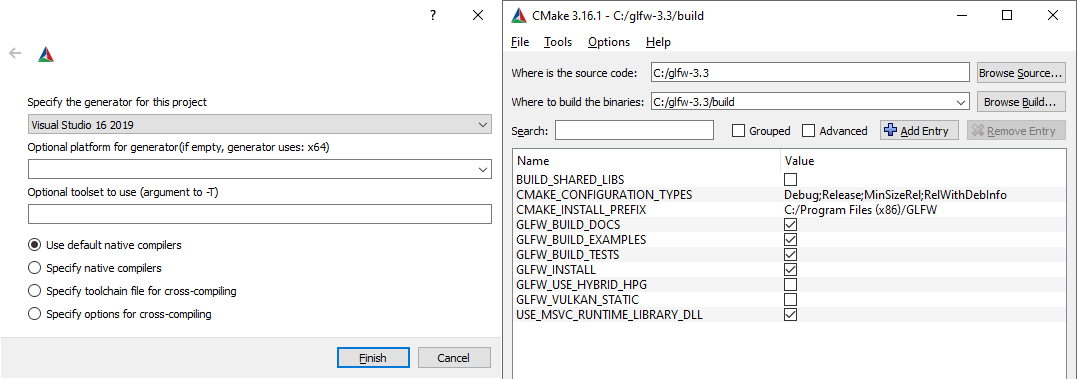
Once the source and destination folders have been set, click the Configure button so CMake can read the required settings and the source code. We then have to choose the generator for the project and since we’re using Visual Studio 2019 we will choose the Visual Studio 16 option (Visual Studio 2019 is also known as Visual Studio 16). CMake will then display the possible build options to configure the resulting library. We can leave them to their default values and click Configure again to store the settings. Once the settings have been set, we click Generate and the resulting project files will be generated in your build folder.
Compilation
In the build folder a file named GLFW.sln can now be found and we open it with Visual Studio 2019. Since CMake generated a project file that already contains the proper configuration settings we only have to build the solution. CMake should’ve automatically configured the solution so it compiles to a 64-bit library. This will give us a compiled library file that can be found in build/src/Debug named glfw3.lib.
Once we generated the library we need to make sure the IDE knows where to find the library and the include files for our OpenGL program. There are two common approaches in doing this:
- We find the
/liband/includefolders of the IDE/compiler and add the content of GLFW’sincludefolder to the IDE’s/includefolder and similarly addglfw3.libto the IDE’s/libfolder. This works, but it’s is not the recommended approach. It’s hard to keep track of your library and include files and a new installation of your IDE/compiler results in you having to do this process all over again. - Another approach (and recommended) is to create a new set of directories at a location of your choice that contains all the header files/libraries from third party libraries to which you can refer to from your IDE/compiler. You could, for instance, create a single folder that contains a
LibsandIncludefolder where we store all our library and header files respectively for OpenGL projects. Now all the third party libraries are organized within a single location (that can be shared across multiple computers). The requirement is, however, that each time we create a new project we have to tell the IDE where to find those directories.
Once the required files are stored at a location of your choice, we can start creating our first OpenGL GLFW project.
Our first project
First, let’s open up Visual Studio and create a new project. Choose Visual C++ if multiple options are given and take the Empty Project (don’t forget to give your project a suitable name). We now have a workspace to create our very first OpenGL application!
Linking
In order for the project to use GLFW we need to link the library with our project. This can be done by specifying we want to use glfw3.lib in the linker settings, but our project does not yet know where to find glfw3.lib since we store our third party libraries in a different directory. We thus need to add this directory to the project first.
We can tell the IDE to take this directory into account when it needs to look for library and include files. Right-click the project name in the solution explorer and then go to VC++ Directories as seen in the image below:
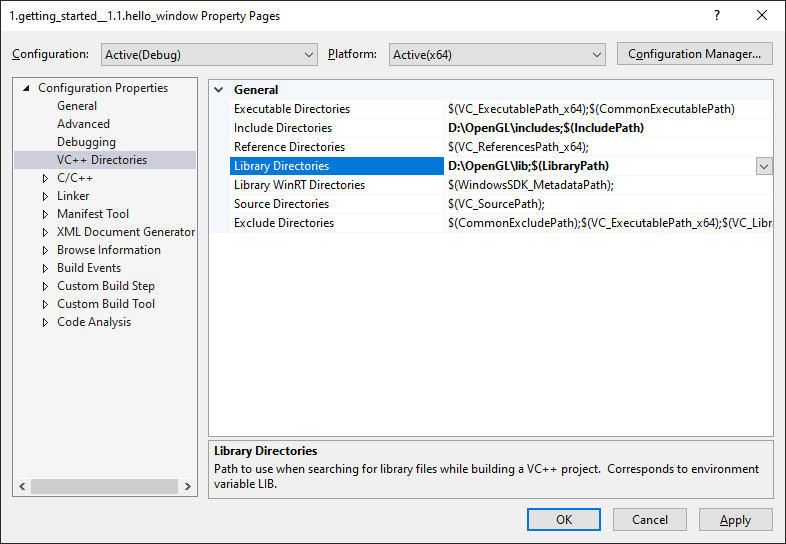
From there on out you can add your own directories to let the project know where to search. This can be done by manually inserting it into the text or clicking the appropriate location string and selecting the <Edit..> option where you’ll see the following image for the Include Directories case:
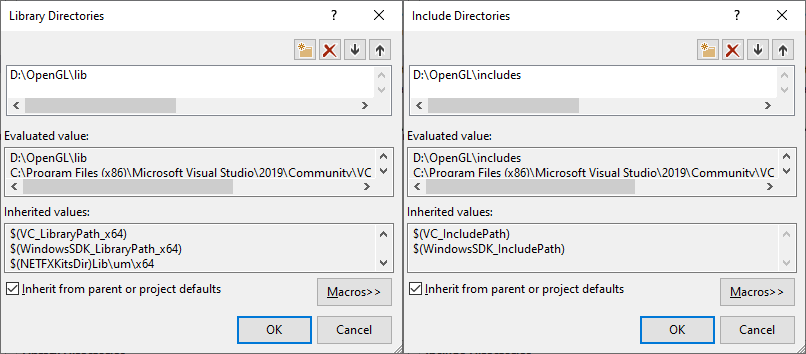
Here you can add as many extra directories as you’d like and from that point on the IDE will also search those directories when searching for header files, so as soon as your Include folder from GLFW is included, you will be able to find all the header files for GLFW by including <GLFW/..>. The same applies for the library directories.
Since VS can now find all the required files we can finally link GLFW to the project by going to the Linker tab and Input:
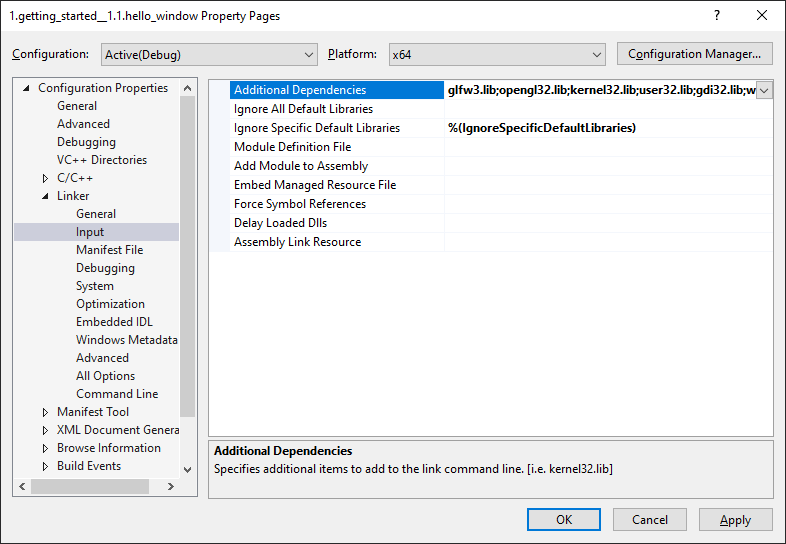
To then link to a library you’d have to specify the name of the library to the linker. Since the library name is glfw3.lib, we add that to the Additional Dependencies field (either manually or using the <Edit..> option) and from that point on GLFW will be linked when we compile. In addition to GLFW we should also add a link entry to the OpenGL library, but this might differ per operating system:
OpenGL library on Windows
If you’re on Windows the OpenGL library opengl32.lib comes with the Microsoft SDK which is installed by default when you install Visual Studio. Since this chapter uses the VS compiler and is on windows we add opengl32.lib to the linker settings.
OpenGL library on Linux
On Linux systems you need to link to the libGL.so library by adding -lGL to your linker settings. If you can’t find the library you probably need to install any of the Mesa, NVidia or AMD dev packages.
Then, once you’ve added both the GLFW and OpenGL library to the linker settings you can include the header files for GLFW as follows:
#include <GLFW\glfw3.h>
For Linux users compiling with GCC, the following command line options may help you compile the project: -lglfw3 -lGL -lX11 -lpthread -lXrandr -lXi -ldl. Not correctly linking the corresponding libraries will generate many undefined reference errors.
This concludes the setup and configuration of GLFW.
GLAD
We’re still not quite there yet, since there is one other thing we still need to do. Because OpenGL is only really a standard/specification it is up to the driver manufacturer to implement the specification to a driver that the specific graphics card supports. Since there are many different versions of OpenGL drivers, the location of most of its functions is not known at compile-time and needs to be queried at run-time. It is then the task of the developer to retrieve the location of the functions he/she needs and store them in function pointers for later use. Retrieving those locations is OS-specific. In Windows it looks something like this:
// define the function's prototype
typedef void (*GL_GENBUFFERS) (GLsizei, GLuint*);
// find the function and assign it to a function pointer
GL_GENBUFFERS glGenBuffers = (GL_GENBUFFERS)wglGetProcAddress("glGenBuffers");
// function can now be called as normal
unsigned int buffer;
glGenBuffers(1, &buffer);
As you can see the code looks complex and it’s a cumbersome process to do this for each function you might need that is not yet declared. Thankfully, there are libraries for this purpose as well where GLAD is a popular and up-to-date library.
Setting up GLAD
GLAD is an open source library that manages all that cumbersome work we talked about. GLAD has a slightly different configuration setup than most common open source libraries. GLAD uses a web service where we can tell GLAD for which version of OpenGL we’d like to define and load all relevant OpenGL functions according to that version.
Go to the GLAD web service, make sure the language is set to C++, and in the API section select an OpenGL version of at least 3.3 (which is what we’ll be using; higher versions are fine as well). Also make sure the profile is set to Core and that the Generate a loader option is ticked. Ignore the extensions (for now) and click Generate to produce the resulting library files.
GLAD by now should have provided you a zip file containing two include folders, and a single glad.c file. Copy both include folders (glad and KHR) into your include(s) directoy (or add an extra item pointing to these folders), and add the glad.c file to your project.
After the previous steps, you should be able to add the following include directive above your file:
#include <glad/glad.h>
Hitting the compile button shouldn’t give you any errors, at which point we’re set to go for the next chapter where we’ll discuss how we can actually use GLFW and GLAD to configure an OpenGL context and spawn a window. Be sure to check that all your include and library directories are correct and that the library names in the linker settings match the corresponding libraries. If you’re still stuck, check the comments, any of the additional resources, or ask your question in the comments below.
Additional resources
- GLFW: Window Guide: official GLFW guide on setting up and configuring a GLFW window.
- Building applications: provides great info about the compilation/linking process of your application and a large list of possible errors (plus solutions) that might come up.
- GLFW with Code::Blocks: building GLFW in Code::Blocks IDE.
- Running CMake: short overview of how to run CMake on both Windows and Linux.
- Writing a build system under Linux: an autotools tutorial by Wouter Verholst on how to write a build system in Linux, specifically targeted for these tutorials.
- Polytonic/Glitter: a simple boilerplate project that comes pre-configured with all relevant libraries; great for if you want a sample project for the LearnOpenGL tutorials without the hassle of having to compile all the libraries yourself.

